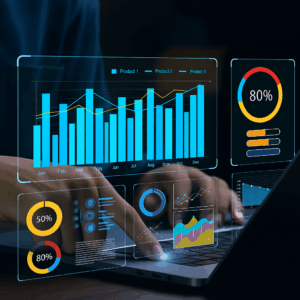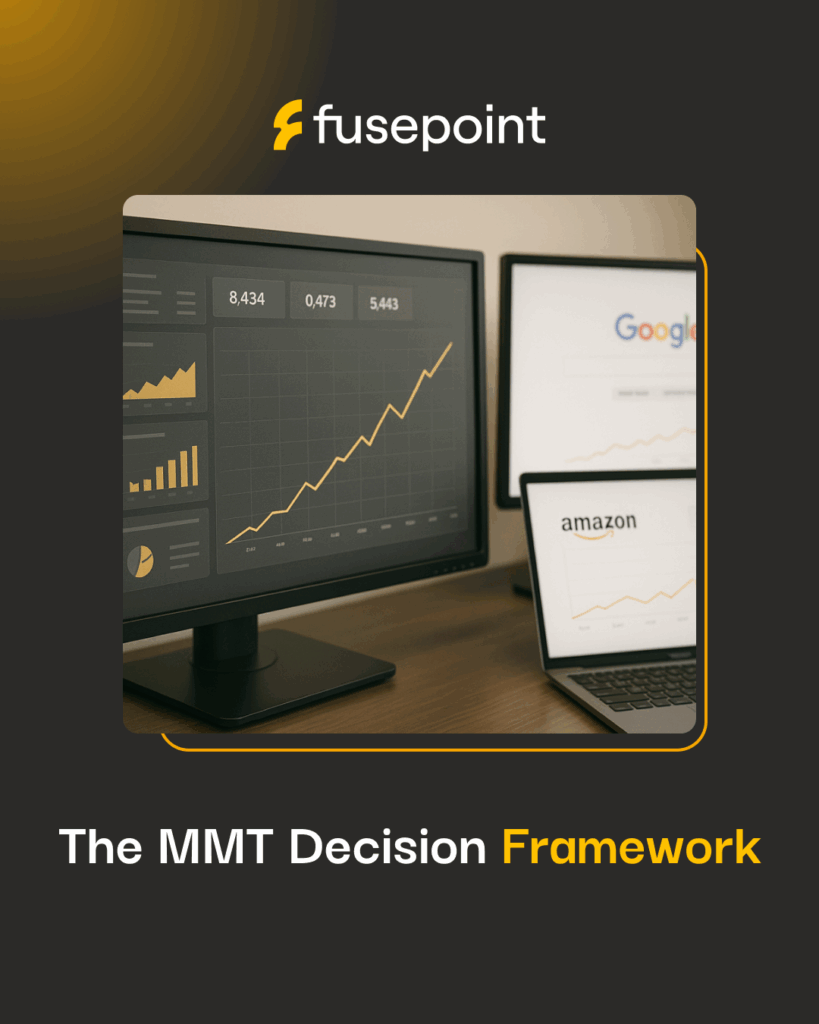How Predictive Customer Analytics Enables Smarter Forecasting and Marketing ROI

- 1. What is predictive customer analytics?
- 2. Key use cases in predictive analytics
- 3. Predictive analysis techniques
- 4. Segmentation-driven predictions
- 5. Regression for interpretability ML for scale and accuracy Segmentation for strategic clarity
- 6. Common pitfalls in predictive analytics
- 7. Predictive analytics at work
- 8. Why fusepoint is the best partner for predictive customer analytics
Most companies forecast in the same way they have always: by looking backward. They take last year’s sales, adjust for seasonality, maybe layer in a marketing plan, and call it a projection. The result is often precise-looking spreadsheets that fail to capture what actually drives customer behavior.
The problem is the lens. Historical reporting shows what happened, but it cannot anticipate future risks. It treats customers as static averages, when in reality their value shifts with acquisition source, product mix, and engagement patterns.
Predictive customer analytics changes that. It models churn, retention, and purchase probability, allowing leaders to see not only what revenue is likely to be, but also which levers will move it higher. More importantly, it moves forecasting from reactive reporting to forward-looking strategy, giving marketing and finance a shared view of growth.
Let’s see how.
What is predictive customer analytics?
Predictive customer analytics uses data science to forecast future customer behavior. Unlike descriptive analytics, which summarizes what has already happened, predictive models estimate what will happen next.
It combines three inputs:
-
Historical customer data – Transactions, engagement patterns, and service interactions
-
Statistical and machine learning models – Regression, survival analysis, decision trees, neural networks
-
Business context – Margins, acquisition costs, retention targets, and budget constraints.
The output is a probability or forecast that ties directly to customer value.
-
For example, a model might estimate that Segment A has a 70% chance of renewing next quarter with an expected margin of $200.
-
Segment B, however, has a 40% chance with $50 in expected margin.
Alone, those probabilities are interesting. Combined with business and customer profitability data, they become the basis for decisions about where to invest in retention or upsell, and where to pull back.
The difference from traditional reporting is crucial: Descriptive analytics looks backward at averages, while predictive analytics projects forward at the segment or customer level. That view makes it possible to anticipate where revenue and profit will come from, rather than waiting to confirm it after the fact.
Key use cases in predictive analytics
Getting predictive analytics right means focusing on the applications that move financial outcomes—not just generating probabilities. Four use cases stand out here.
Churn prediction
Churn prediction estimates which customers are most likely to leave and when. To assign risk, models use behavioral signals such as:
-
Purchase frequency
-
Engagement drops
-
Service complaints
Attrition quickly erodes long-term value. Telecom firms, for example, report annual churn rates of 15 to 25%, while subscription apps face even higher first-year churn rates. Here, predictive analytics customer churn allows businesses to intervene before revenue is lost.
The goal is not to prevent every defection—it’s to focus retention efforts where the margin impact justifies the cost. For example, if a SaaS firm predicts a 20% churn risk for a cohort generating $2 million in ARR, preventing even half of those defections saves $200,000 in margin, far outweighing the intervention costs.
Retention modeling
Where churn prediction flags risk, retention modeling estimates how long a customer is likely to stay. So, the focus is on customer retention and the value they generate..
Survival analysis applies time-to-event logic to predict exactly when a customer churns. Consider this: A streaming service might find that customers acquired through bundle deals stay only three months, while those who join organically renew for 18 months. Without predictive analytics for customer retention, both groups look equally valuable on a revenue chart.
The business implication is straightforward: retention is leverage. Even extending average tenure by one renewal cycle can produce outsized increases in CLV and profitability. (Click HERE for an easy CLV formula)
Personalization at scale
Predictive analytics enables brands to transition from one-size-fits-all campaigns to personalized offers that anticipate future behavior.
Rather than discounting broadly, businesses can target customers with the highest probability of incremental action. According to McKinsey, personalization at scale can drive revenue growth of 10% to 15% when done effectively.
Apart from the obvious revenue benefit, predictive personalization also helps you avoid spending on customers who would have purchased anyway.
ROI and profitability forecasting
Predictive analytics also connects customer behavior directly to future financial outcomes.
Instead of asking, “What did this channel return last quarter?” the question becomes “What will these customers contribute over the next year, and how does that change if we shift spend?” By projecting churn, retention, and purchase probability, predictive models estimate future CLV, payback periods, and margin contribution.
Consider a retailer planning holiday budgets.
-
Traditional reporting might show that paid social drove the most revenue last year, so the team doubles down on it.
-
A predictive model, however, reveals that many of those conversions came from low-margin, one-time buyers, while email-nurtured customers who returned three or four times generated a higher lifetime profit.
-
Armed with that forecast, leadership can redirect dollars toward the channel that compounds value the most.
Predictive analysis techniques
The power of predictive analytics lies in the methods used to generate forecasts.
Regression and trend modeling
Regression is the backbone of predictive analytics. It models the relationship between:
-
Inputs (like ad spend, pricing, or customer engagement)
-
Outcomes (churn probability, purchase frequency, and margin contribution)
Linear and logistic regressions remain widely used because they’re interpretable and finance-friendly, helping leaders see which factors drive outcomes and by how much.
For example, a subscription company might use logistic regression to predict the likelihood that customers with declining weekly logins will cancel within the next 90 days. Trend models extend this by projecting how retention or sales volumes shift over time.
The advantage is transparency. Regression models can be explained in board meetings and linked directly to business levers.
However, they may struggle when data relationships are highly non-linear or influenced by hundreds of variables.
Machine learning models
Machine learning (ML) techniques (such as decision trees, random forests, gradient boosting, and neural networks) handle more complexity than traditional regression. They excel at finding hidden patterns across large, noisy datasets.
-
In retail, an ML model might analyze purchase history, browsing behavior, and support interactions to predict which customers are likely to make a second purchase within 30 days.
-
In insurance, gradient boosting can rank policyholders by likelihood to renew based on dozens of behavioral and demographic features.
ML often delivers stronger predictive accuracy than regression, especially at scale. But the trade-off is interpretability. A random forest may identify a customer as high-risk without clarifying the reasons. This is why pairing ML with profitability metrics is critical: A “black box” prediction without a business lens risks becoming a vanity exercise.
Segmentation-driven predictions
Segmentation-driven approaches group customers by shared characteristics (such as acquisition source, product mix, geography, and engagement) and forecast outcomes at the cohort level.
Instead of predicting at the individual customer level, the model estimates retention, churn, or margin for each segment.
For example, in B2B SaaS, segmentation may reveal that mid-market accounts renew more predictably than enterprise clients, even though enterprise deals generate larger upfront revenue.
Segmentation-driven models are less granular than ML, but they provide clarity for resource allocation. They expose which cohorts are worth acquiring, which require different pricing, and which should be deprioritized entirely.
In practice, the strongest predictive systems combine these techniques:
Regression for interpretability ML for scale and accuracy Segmentation for strategic clarity
Predictive analytics proves its value when forecasts translate into better financial decisions, and two applications stand out above all else.
Scenario planning and budgeting
At its core, predictive analytics helps model how different spending scenarios are likely to unfold.
-
A subscription business, for example, can forecast what happens to revenue if churn drops by two points in the next quarter. That change may look small, but when modeled, it translates into thousands of additional customers retained and millions in incremental CLV.
-
In retail, predictive models can simulate how shifting 10% of ad spend from paid social to loyalty programs affects both near-term sales and long-term repeat purchase rates.
The result is a forward-looking budget that accounts for costs and replaces “best guess” planning with evidence-backed forecasts.
Resource allocation based on predicted value
Next, predictive analytics tells you where to allocate your funds best when media planning.
-
In SaaS, a model might show that mid-market customers have a 70% chance of renewal and a projected three-year CLV of $50,000, while enterprise clients renew at only 40% and require higher service costs. With that insight, sales predictive analytics can help allocate resources toward the mid-market, where profitability compounds more quickly.
-
In travel, a predictive model might show that customers booking directly through the brand’s website are twice as likely to purchase add-ons (such as seat upgrades) compared to those coming through third-party aggregators. With that insight, marketing dollars can now strengthen direct channels.
The bottom line is that predictive analytics makes it possible to ask “what if” questions before dollars are committed.
Common pitfalls in predictive analytics
Predictive analytics is powerful, but only when built and applied correctly.
Poor data quality
The accuracy of any prediction depends on the quality of the inputs; Gartner estimates that poor data costs organizations an average of $12.9 million annually in lost business.
Incomplete, inconsistent, or siloed data introduces noise that models can’t correct for. A churn model trained on transactional data but missing service interactions, for instance, may misdirect retention spend.
Overfitting to history
Models can be tuned so tightly to historical patterns that they fail when conditions change. A retail model built on pre-pandemic shopping behavior, for example, would have dramatically misforecast online demand in 2020.
To address this, you must rigorously backtest and monitor your models to ensure they accurately reflect the real world.
Chasing vanity metrics
A churn model with 90% accuracy is meaningless if it doesn’t differentiate between high-margin and low-margin customers. Predictive analytics must connect to profitability, not just probability.
In practice, this means weighting reductions by margin and acquisition cost. Retaining a low-value cohort may appear to be “reduced churn,” but it actually affects ROI negatively if the retention cost exceeds the return.
No actionability
The most common failure is predictions that never change decisions. A model might flag 10,000 customers as likely to churn, but if there’s no plan to intervene (or if the interventions cost more than the value saved), the model adds no business impact.
Predictive analytics must be embedded into every stage of decision-making, including retention strategies, budget allocation, and pricing.
Predictive analytics at work
Two recent fusepoint engagements show just how effective predictive analytics can be.
A journey to retail dominance
A leading haircare brand was at risk of cutting back on its DTC media budget after attribution models suggested weak performance. Some key findings from this multi-channel marketing case study include:
-
On the surface, spending looked siloed and inefficient.
-
However, when fusepoint applied incrementality testing and predictive modeling, the picture changed.
-
The data showed that digital campaigns were driving significant halo effects in Amazon and retail channels, which were often invisible in last-click reporting.
By reframing the spend as part of an interconnected ecosystem, the brand’s leadership reallocated budgets, leading to a 2.87 times measured halo lift in retail. What appeared to be wasted spend was, in fact, one of the strongest drivers of omnichannel growth.
How fusepoint uncovered $400K in hidden profit
A voluntary insurance brand faced a different challenge: rising acquisition costs and shrinking margins. Attribution pushed them toward doubling down on oversaturated demand-capture channels.
In response, fusepoint applied predictive profitability forecasting across its mix and identified underutilized channels that delivered better efficiency. With these forecasts, the brand rebalanced its mix, achieving a 167% lift in incremental revenue, a 33% boost in AOV, and nearly $400K in incremental profit—all without increasing total spend.
In both cases, predictive analytics delivered what backward-looking reports could not: a finance-grade view of future profitability, even with all of the challenges of insurance marketing.
Why fusepoint is the best partner for predictive customer analytics
If your forecasts are built only on historical reports, you’re driving with the rearview mirror. Predictive analytics consulting enables businesses like yours to stress-test investments before they’re made and identify the compounding value that others overlook.
fusepoint builds predictive systems designed to withstand this pressure. Our approach combines:
-
Advanced modeling – Regression, machine learning, and segment-level predictions.
-
Incrementality testing – Testing how well models hold up in live market conditions.
-
Profitability focus – Tying every prediction back to CAC, CLV, and margin, so marketing and finance speak the same language.
At fusepoint, we partner with teams who want to know how tomorrow’s revenue will stack up against today’s investment. Discover how we can give you that advantage today.
Sources
UNSW Sydney Online. Descriptive, predictive and prescriptive analytics: What are the differences? https://studyonline.unsw.edu.au/blog/descriptive-predictive-prescriptive-analytics
MDPI. Deep Churn Prediction Method for Telecommunication Industry. https://www.mdpi.com/2071-1050/15/5/4543
ResearchGate. Applying Survival Analysis to Telecom Churn Data. https://www.researchgate.net/publication/345498580_Applying_Survival_Analysis_to_Telecom_Churn_Data
McKinsey & Company. The value of getting personalization right—or wrong—is multiplying.
MDPI. Exploring the Interaction Effects of Board Meetings on Information Disclosure and Financial Performance in Public Listed Companies. https://www.mdpi.com/2227-7099/9/4/139
Taylor and Francis Group. Data-Driven Decision-Making in Entrepreneurship: Tools for Maximizing Human Capital.
McKinsey & Company. Driving impact at scale from automation and AI.
Gartner. Data Quality: Best Practices for Accurate Insights. https://www.gartner.com/en/data-analytics/topics/data-quality
Journal of Retailing and Consumer Services. Online shopping continuance after COVID-19: A comparison of Canada, Germany and the United States. https://pmc.ncbi.nlm.nih.gov/articles/PMC9379614/
Our Editorial Standards
Reviewed for Accuracy
Every piece is fact-checked for precision.
Up-to-Date Research
We reflect the latest trends and insights.
Credible References
Backed by trusted industry sources.
Actionable & Insight-Driven
Strategic takeaways for real results.










